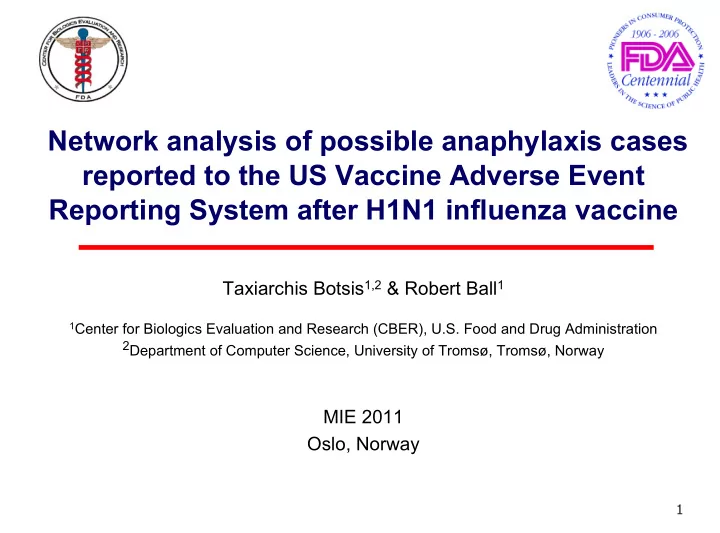

Network analysis of possible anaphylaxis cases reported to the US Vaccine Adverse Event Reporting System after H1N1 influenza vaccine Taxiarchis Botsis 1,2 & Robert Ball 1 1 Center for Biologics Evaluation and Research (CBER), U.S. Food and Drug Administration 2 Department of Computer Science, University of Tromsø, Tromsø, Norway MIE 2011 Oslo, Norway 1
Vaccine Adverse Event Reporting System (VAERS) n VAERS stores adverse events (AEs) reported by: n health care providers n vaccine recipients n manufacturers n Well-trained nurses code these reports: n using the Medical Dictionary for Regulatory Activities (MedDRA) and n assign preferred terms (PTs) that represent the AEs described in the narratives. 2
Study hypothesis n Identify patterns and n Detect safety signals by applying Network Analysis to VAERS 3
Methods: Dataset 6034 VAERS reports for H1N1 vaccine n (November 22, 2009-January 31, 2010) 237 possible anaphylaxis reports n Anaphylaxis: acute allergic reaction after n vaccination Dataset of 237 reports used to identify n patterns of PTs related to anaphylaxis 4
Methods: Network Analysis Report_1= [VAX1 VAX2 PT1 PT2 PT3] # reports containing this tie decomposed to combinations of: PT1 PT2 PT3 VAX1 VAX2 VAX1 16 33 5 0 50 VAX1-PT1, VAX1-PT2, VAX1-PT3, VAX2 4 10 5 Report_1+ Report_2+ … + Report_n 50 0 VAX2- PT1, VAX2- PT2, VAX2- PT3 PT1 0 12 10 16 4 PT2 12 0 9 33 10 And PT3 10 9 0 5 5 VAX1-VAX2 And PT1- PT2, PT1- PT3, PT2-PT3 VAX1, VAX2: Vaccines PT1, PT2, PT3: MedDRA Preferred Terms (PT) representing adverse events 5
Methods: Network construction n Nodes the PTs and vaccines n Edges their interconnections n Edge weight the number of occurrences for each tie 6
Methods: Network reduction Application of the ‘islands’ algorithm* to anaphylaxis network: n identifies all the maximal islands within a predefined node interval for an edge weight threshold And combine it with: n triangular weight – TW (= number of triangles each edge of the original network is contained). n TWs emphasize multiple interactions, filter out weak connections and reveal the patterns. * M. Zaversnik and V. Batagelj, Islands, Sunbelt XXIV, 2004. 7
Results: Anaphylaxis network N=301 nodes What a mess! 8
Results: Reduced network It is clear N=30 nodes now! Brighton Collaboration Criteria 9
Summary n Network analysis identifies patterns related to adverse events after vaccination 1 n Limitations: n Statistical framework of network analysis n Retrospectively collected dataset n Future goals: n Evaluation of other approaches for network reduction and n Application to prospectively collected data for prediction purposes. 1 R. Ball and T. Botsis, Can network analysis improve pattern recognition among adverse events following immunization reported to VAERS? Clinical Pharmacology & Therapeutics. 2011 Aug;90(2):271-8. 10
Acknowledgements n We thank the Medical Officers at FDA who evaluated the reports and those who reported them. n Research Participation Program, Center for Biologics Evaluation and Research, Oak Ridge Institute for Science and Education 11
Recommend
More recommend